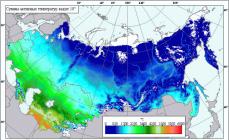TABLE VARIETIES
Almaty early. Bred at the Kazakh Research Institute of Fruit and Viticulture (KazNIIPiV). Very early ripening variety. The growth of the bushes is average. Clusters are medium in size and firm. The berries are medium, round - from light green to golden yellow, sweet. The pulp is juicy, fleshy. The taste is very pleasant, with a nutmeg aroma. The skin is thin, not felt when eating. The yield is good. In some years, it is damaged by powdery mildew. Recommended in Almaty, Zhambyl and South Kazakhstan regions.
Black kishmish. Seedless variety of early-middle ripening period.
The growth of the bushes is strong. The clusters are large, medium density and loose. The berries are medium, oval, dark blue, covered with a waxy bluish bloom. The skin is of medium thickness. The pulp is juicy and crispy. The berries have a very good taste, there are no seeds in them. They are used both fresh and used for drying. Low frost resistance, thermophilic variety. It gives good yields - up to 180 centners per hectare. Zoned for the south and southeast of Kazakhstan.
Queen of the vineyards. Early ripening variety. The clusters are large, of medium density. The berries are very large, oval, golden amber in color. The skin is quite firm. The pulp is fleshy, juicy, with a delicate nutmeg aroma. Average frost resistance, good yield. Zoned in the main zones of the south and southeast of Kazakhstan.
Hungarian Muscat. A versatile table and wine variety with an early-medium ripening period. Bunches of medium size, medium density, often loose. The berries are rather large, dull green, with a strong waxy bloom. The skin is dense, thick, and is felt when consumed. The pulp is fleshy, crispy, juicy. The taste is very pleasant, with a strong nutmeg aroma. Low frost resistance, good harvest, stable over the years. Zoned in all zones of Kazakhstan's viticulture.
Nimrang. High quality late ripening variety. The growth of the bushes is strong. The bunches are large, medium-dense or loose. The berries are large, light green, with a dark pink barrel. The skin is thick and firm. The pulp is dense, fleshy, crunchy. The taste of the berries is very pleasant. Leaving yield is good. Average winter hardiness. Zoned in South Kazakhstan, Zhymbyl, Kyzylorda regions and in the south-eastern zone of Almaty region.
Taifi pink. High quality late ripening variety. The growth of the bushes is strong. The bunches are very large (individual ones weigh 2 kg or more), medium density, often loose. The berries are very large, dark pink or pink in color. The skin is dense, with a thick waxy bloom. The flesh is crispy. The taste of the berries is very pleasant. Weak winter hardiness, high yield. Less other varieties are affected by powdery mildew. It is zoned in the South Kazakhstan, Kyzylorda, as well as in the plain zone of the Zhambyl and the southeastern zone of the Almaty regions.
Terbash. A versatile medium-ripening table and wine variety. The growth of the bushes is average. The clusters are rather large, of medium density. The berries are amber yellow. The skin is dense, with a thick waxy coating. The pulp is fleshy, juicy, the taste is pleasant, slightly tart. More winter hardy than other varieties of the eastern group. When leaving, it gives high yields. Zoned in the South Kazakhstan, Zhambyl regions and the southeastern and plain-steppe zones of the Almaty region.
Husayne is white. Late ripening variety. People call it "ladies' fingers". The growth of the bushes is average. The bunches are very large, loose, branchy. The berries are large, elongated in the form of fingers (hence the second name), yellowish-green when fully ripe. The skin is thin but firm. The pulp is fleshy, juicy. Berries have a very pleasant taste. Productivity is good, average winter hardiness. Zoned in the main zones of viticulture of the republic.
WINE VARIETIES
Aligote. Early-medium ripening variety. It is used for the preparation of champagne wine materials and table wines. The growth of the bushes is average. The clusters are small to medium in size, almost cylindrical, very dense. Berries are medium in size, greenish-white, often deformed due to tight compression in the bunch. The skin is thin, the pulp is juicy. The yield is above average. Winter hardiness is quite high. Zoned in Almaty, Zhambyl and South Kazakhstan regions. It can also be grown in the Urdzhar and Zaysan districts of the East Kazakhstan region.
Bayan shirey. Late ripening variety. It is used for the manufacture of table wines and cognac wine materials, and is also consumed fresh. The growth of the bushes is strong. Clusters are medium to large in size, medium density or loose. Berries are medium to large, greenish yellow. The skin is firm, with a thick waxy bloom. The pulp is juicy, the taste is pleasant, refreshing. Differs in high productivity, winter hardiness is above average. In areas with deep snow cover, it can winter in a pinned state. Zoned in the southeastern zone of the Almaty and plain zones of the Zhambyl and South Kazakhstan regions.
Kuldzhinsky. Wine and table variety of late ripening.
Gives good table wines, cognac and champagne wine materials. The growth of the bushes is strong. The bunches are very large (up to 1.5 kg), dense. The berries are medium in size, pink or dark pink in color. The skin is firm. The pulp is juicy. The variety is high-yielding, winter hardiness is low, therefore, the bushes must be covered before the onset of autumn frosts. Zoned in the southeastern zone of the Almaty region and the central zone of the South Kazakhstan region.
May black. A variety of medium-late ripening. Produces high quality dessert wines. The growth of the bushes is average. Clusters are medium in size, medium density or dense. The berries are medium, dark blue, almost black, covered with a thick waxy bloom. The skin is rough. The pulp is juicy. Differs in increased frost resistance, can winter without shelter, pinned to the ground. Unlike other varieties, it is slightly affected by powdery mildew. It also has a constant high yield. Zoned in the southern zones of the Kyzylorda, South Kazakhstan regions and the southeastern zone of the Almaty region.
Muscat pink. Variety of medium-late ripening period. Used for making dessert wines. The growth of the bushes is strong. Clusters are medium in size and firm. The berries are medium-sized, dark red, almost black, covered with a thick waxy bloom. The skin is thin, easily separated from the pulp. The pulp is juicy, tender, with a strongly pronounced nutmeg aftertaste. A variety with good productivity, low winter hardiness. Zoned in the main zones of viticulture in Kazakhstan.
Riesling. High quality variety of medium-late ripening period.
It is used for the preparation of dry and semi-sweet table wines and juices. The growth of the bushes is average. The clusters are small, of medium density. The berries are small, light green, with black dots and a waxy coating. The skin is of medium thickness. The pulp is juicy, melting, a specific varietal aroma is inherent in the taste. Differs in increased frost resistance, can winter without shelter in a pinned form. Zoned in the main zones of viticulture of the republic.
Rkatsiteli. A versatile, high-quality, late-ripening variety. It is used for the preparation of table, strong dessert wines and juices. The growth of the bushes is average. Bunches of medium size and density. The berries are medium-sized, greenish-white. The skin is thin, easily separated from the pulp. The pulp is juicy, spreading. Differs in increased frost resistance, overwinters well in a state bent to the ground without shelter under the snow. Produces high annual yields. Weakly affected by powdery mildew. Zoned in all zones of the south and south-east of Kazakhstan.
Early ripening of any berry is attractive to gardeners, especially those living in harsh climatic conditions. Grapes are no exception, because, once a southern berry, it has conquered new growing areas with colder atmospheric influences.
Early grape varieties: species characteristics
Breeders have bred many varieties of early ripening, so that residents of middle and northern latitudes can enjoy the berry grown by their own hands at the end of summer. The most common early maturing grapes are:
- By mid-August, small berries of the Tason variety are gaining final ripeness, which is characterized by juicy crunchy pulp in a thin skin shell. Attracts the taste of the variety - sweetness with the astringency of nutmeg.
- Pink Libya, created by the breeder Zagorulko, pleases with large fruits with a sweet and sour taste and delicate aroma. It is prone to defeat mildew, but you can heal the bushes with two.
- The most picky early grape variety is considered to be Codryanka, which can also bear fruit in impoverished lands. Dark purple berries of the variety reach ripeness in 120 days, surprise with their impeccable appearance and pleasant taste. The variety is quite resistant to cold weather and diseases of the vine. The bunches are not damaged during transportation.
- White Delight belongs to table early grape varieties, characterized by massive bunches of almost two kilograms. Berries of this type are long with a yellowish tinge, juicy, with a balance of sugar and acid. They are stored for a very long time without losing their visual appeal. When growing, it requires as much light and solar heat as possible, it does not tolerate frost well.
- The Violet variety is very fertile, which fully ripens in early September. Most of its shoots are fruitful. Round grapes are juicy, sweet, but not sugary. The variety is not afraid of cold snaps even below 20 degrees, but the disadvantage is its tendency to various bacterial lesions. When planting this type of grape, it is imperative to tie up the vine, often loosen the soil and weed the bushes.
- The superearly varieties include, which matures after 95 days. It has berries of a deep pink color, medium size, slightly elongated. It tastes good with a lot of sweetness. It is resistant to both diseases and frost.
- The Aleshenkin variety pleases with a high yield: from one bush up to ten kilograms, you can collect light juicy berries. It tastes very sweet, without sourness. Gardeners appreciate its simplicity in growing and resistance to cold. The only drawback is susceptibility to disease and.
There are a lot of early grape varieties offered by specialists, and their selection continues. And which variety is suitable for a particular winegrower, for this you need to get acquainted with the taste characteristics of the species, its resistance to disease and frost, and methods of cultivation. And then you can already make a choice.

To prepare for growing grapes with an early ripening period, you need to choose a place in the garden that will be most comfortable for its growth. The vines are suitable for the southern slopes, which are best protected from cold winds.
When preparing the soil for planting, you need to know that early grapes grow well on light soils, neutral in composition.
As soon as the spring soil warms up, the prepared seedlings are lowered into a hole prepared up to 50 centimeters deep, after adding gravel drainage and nutritious soil to it. Before planting, the roots of a young plant can be immersed in a liquid clay solution with the addition of cow dung.
It is imperative to maintain a distance between plantings of up to two meters, not forgetting about supports for shoots. The right type of soil and the right planting will allow you to feast on ripe bunches in the summer months.

Throughout the growing season, grapes are fed with either manure or chicken droppings. You can prepare a mixture for additional nutrition of the vine yourself: compost from rotted plants with the addition of peat, manure and hay.
In order to prevent shedding of the ovaries, foliar boric acid is used, which is carried out twice: before the opening of the flowers and after the appearance of the berries. it is abundantly carried out in the initial period of grape growth, in the second - they reduce the access of moisture, because its excess will lead to a delay in the growth of shoots that will not have time to ripen before frost.
One of the main points of growing early grape varieties is their timely release from the covering material after wintering.
Here it is important not to rush when the first warmth comes, otherwise the subsequent frosts will kill the overwintered plants. Only when the comfortable weather is finally established, you can open the vine by treating it with a solution of vitriol, copper or iron. This will help avoid and delay bud break. No special effort is required to grow vineyards.

Many early ripening grape varieties are prone to diseases:
- Oidium, or powdery mildew, damages the green parts of the vine. Shoots and leaves covered with a gray-ash bloom smell of rot, the inflorescences dry. To avoid this ailment, before the formation of flowers, the vine is treated with Quadris or Flint, then the operation is repeated several times over the summer.
- A dangerous fungal disease with mildew affects almost all ground parts of grapes. On the leaves above and below, yellowish or greenish oily spots of various shapes are visible. If you do not fight the disease, the leaves will dry out and fall off. Plants are infected with downy mildew either in the rainy season or in hot weather. To avoid infection, it is necessary to better ventilate the vineyards, fight weeds in time, and remove and destroy the affected leaves.
- Early grape varieties often develop anthracnose, grapepox, the external symptoms of which appear on the greenery and berries of the plant. The affected parts fall out over time, forming holes on the sheets, and brown spots with a red rim pushed inward are visible on the fruits. Without treatment, the plant may die. To combat the disease, Bordeaux liquid is used several times during the growing period of grapes in the morning and evening.
Diseases of the grapes can be avoided if the vine is properly cared for.
More information can be found in the video.
Almaty early. Bred at the Kazakh Research Institute of Fruit and Viticulture (KazNIIPiV). Very early ripening variety. The growth of the bushes is average. Clusters are medium in size and firm. The berries are medium, round - from light green to golden yellow, sweet. The pulp is juicy, fleshy. The taste is very pleasant, with a nutmeg aroma. The skin is thin, not felt when eating. The yield is good. In some years, it is damaged by powdery mildew. Recommended in Almaty, Zhambyl and South Kazakhstan regions.

Black kishmish. Seedless variety of early-middle ripening period.
The growth of the bushes is strong. The clusters are large, medium density and loose. The berries are medium, oval, dark blue, covered with a waxy bluish bloom. The skin is of medium thickness. The pulp is juicy and crispy. The berries have a very good taste, there are no seeds in them. They are used both fresh and used for drying. Low frost resistance, thermophilic variety. It gives good yields - up to 180 centners per hectare. Zoned for the south and southeast of Kazakhstan.

Queen of the vineyards. Early ripening variety. The bunches are large, of medium density. The berries are very large, oval, golden amber in color. The skin is quite firm. The pulp is fleshy, juicy, with a delicate nutmeg aroma. Average frost resistance, good yield. Zoned in the main zones of the south and southeast of Kazakhstan.

Hungarian Muscat. A versatile table and wine variety with an early-medium ripening period. Bunches of medium size, medium density, often loose. The berries are rather large, dull green, with a strong waxy bloom. The skin is dense, thick, and is felt when consumed. The pulp is fleshy, crispy, juicy. The taste is very pleasant, with a strong nutmeg aroma. Low frost resistance, good harvest, stable over the years. Zoned in all zones of viticulture in Kazakhstan.

Nimrang. High quality late ripening variety. The growth of the bushes is strong. The bunches are large, medium-dense or loose. The berries are large, light green, with a dark pink barrel. The skin is thick and firm. The pulp is dense, fleshy, crunchy. The taste of the berries is very pleasant. Leaving yield is good. Average winter hardiness. Zoned in South Kazakhstan, Zhymbyl, Kyzylorda regions and in the southeastern zone of Almaty region.

Taifi pink. High quality late ripening variety. The growth of the bushes is strong. The bunches are very large (individual ones weigh 2 kg or more), medium density, often loose. The berries are very large, dark pink or pink in color. The skin is dense, with a thick waxy bloom. The pulp is crispy. The taste of the berries is very pleasant. Weak winter hardiness, high yield. Less other varieties are affected by powdery mildew. It is zoned in the South Kazakhstan, Kyzylorda, as well as in the plain zone of the Zhambyl and southeastern zones of the Almaty regions.

Terbash. A versatile medium-ripening table and wine variety. The growth of the bushes is average. The clusters are rather large, of medium density. The berries are amber yellow. The skin is dense, with a thick waxy coating. The pulp is fleshy, juicy, the taste is pleasant, slightly tart. More winter-hardy than other varieties of the eastern group. When leaving, it gives high yields. Zoned in the South Kazakhstan, Zhambyl regions and the southeastern and plain-steppe zones of the Almaty region.

Husayne is white. Late ripening variety. People call it "ladies' fingers". The growth of the bushes is average. The bunches are very large, loose, branchy. The berries are large, elongated in the form of fingers (hence the second name), yellowish-green when fully ripe. The skin is thin but firm. The pulp is fleshy, juicy. Berries have a very pleasant taste. Productivity is good, average winter hardiness. Zoned in the main zones of viticulture of the republic.
WINE VARIETIES

Early-medium ripening variety. It is used for the preparation of champagne wine materials and table wines. The growth of the bushes is average. The clusters are small to medium in size, almost cylindrical, very dense. Berries are medium in size, greenish-white, often deformed due to tight compression in the bunch. The skin is thin, the pulp is juicy. The yield is above average. Winter hardiness is quite high. Zoned in Almaty, Zhambyl and South Kazakhstan regions. It can also be grown in the Urdzhar and Zaysan districts of the East Kazakhstan region.

Bayan shirey. Late ripening variety. It is used for the production of table wines and cognac wine materials, and is also consumed fresh. The growth of the bushes is strong. Clusters are medium to large in size, medium density or loose. Berries are medium to large, greenish yellow. The skin is firm, with a thick waxy coating. The pulp is juicy, the taste is pleasant, refreshing. Differs in high productivity, winter hardiness is above average. In areas with deep snow cover, it can winter in a pinned state. Zoned in the southeastern zone of the Almaty and plain zones of the Zhambyl and South Kazakhstan regions.

Kuldzhinsky. Wine and table variety of late ripening.
Gives good table wines, cognac and champagne wine materials. The growth of the bushes is strong. The bunches are very large (up to 1.5 kg), dense. The berries are medium in size, pink or dark pink in color. The skin is firm. The pulp is juicy. The variety is high-yielding, winter hardiness is low, therefore, the bushes must be covered before the onset of autumn frosts. Zoned in the southeastern zone of the Almaty region and the central zone of the South Kazakhstan region.

May black. A variety of medium-late ripening. Produces high quality dessert wines. The growth of the bushes is average. Clusters are medium in size, medium density or dense. The berries are medium, dark blue, almost black, covered with a thick waxy coating. The skin is rough. The pulp is juicy. Differs in increased frost resistance, can winter without shelter, pinned to the ground. Unlike other varieties, it is slightly affected by powdery mildew. It also has a constant high yield. Zoned in the southern zones of the Kyzylorda, South Kazakhstan regions and the southeastern zone of the Almaty region.

Muscat pink. Variety of medium-late ripening period. Used for making dessert wines. The growth of the bushes is strong. Clusters are medium in size and firm. The berries are medium-sized, dark red, almost black, covered with a thick waxy bloom. The skin is thin, easily separated from the pulp. The pulp is juicy, tender, with a strongly pronounced nutmeg aftertaste. A variety with good productivity, low winter hardiness. Zoned in the main zones of viticulture in Kazakhstan.

Riesling. High quality variety of medium-late ripening period.
It is used for the preparation of dry and semi-sweet table wines and juices. The growth of the bushes is average. The clusters are small, of medium density. The berries are small, light green, with black dots and a waxy coating. The skin is of medium thickness. The pulp is juicy, melting, a specific varietal aroma is inherent in the taste. Differs in increased frost resistance, can winter without shelter in a pinned form. Zoned in the main zones of viticulture of the republic.

Rkatsiteli. A versatile, high-quality, late ripening variety. It is used for the preparation of table, strong dessert wines and juices. The growth of the bushes is average. Bunches of medium size and density. Berries are medium-sized, greenish-white. The skin is thin, easily separated from the pulp. The pulp is juicy, spreading. Differs in increased frost resistance, overwinters well in a state bent to the ground without shelter under the snow. Produces high annual yields. Weakly affected by powdery mildew. Zoned in all zones of the south and southeast of Kazakhstan.

Saperavi. Late ripening variety. Used to prepare high quality wines. The growth of the bushes is strong. Clusters are medium in size, medium density or loose. The berries are medium-sized, dark blue, with a thick bluish waxy bloom. The skin is thin. The pulp is juicy, melting, with a densely colored juice. The variety is characterized by increased frost resistance and can hibernate in a pinned state under snow without shelter. The yield is average. Strongly damaged by powdery mildew. Zoned in most areas of the south and southeast of Kazakhstan.
Magzhan ISIN, Doctor of Biological Sciences, Professor






